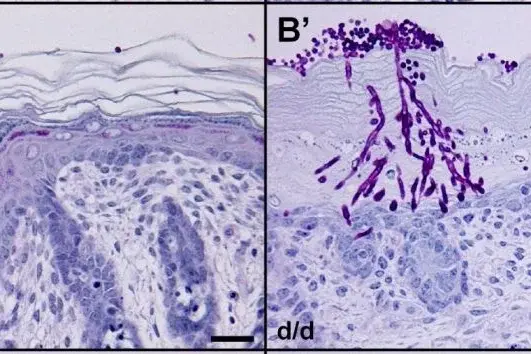Research Group Lipid Pathobiochemistry

PD Dr. Roger Sandhoff
Within our research group “Lipid Pathobiochemistry” we investigate the endogenous and pathological functions of sphingolipids. Sphingolipids are a complex class of membrane lipids (ceramides, cerebrosides, sphingomyelins, complex glycosphingolipids, gangliosides, and sulfatides), but contain also some important extra and intracellular signaling molecules, such as sphingosine 1-phosphate. They are derived by combinatorial biochemistry at the membranes of the endoplasmic reticulum and Golgi apparatus of the cells. Cell intrinsic expressions of various enzymes generate cell-specific sphingolipid patterns, which depend on cell differentiation, cell activation, but also cell transformation, e.g. to cancer cells.
The ganglioside GD2, a glycosphingolipid, for example is expressed quite selectively on various tumor cells and is prominent in neuroblastoma thereby serving as a cancer therapy target. Sphingolipids in turn modulate cellular processes like proliferation, type of differentiation or activation, and can also influence the potential of tumor cells to metastasize. Although present in all cells of the organism, sphingolipids can have quite different functions. Cerebrosides and sulfatides contribute to the structure of myelin sheaths whereas special ceramides are essential for a functional lipid based skin barrier, a barrier that allows us to live on land.
Specific gangliosides on the surface of axons interact with lectins of the surrounding myelin sheaths and stabilize by that the membrane-membrane interaction. Other glycosphingolipids are essential for the structure of intercellular bridges between maturating spermatids of a clone. Within cell membranes, sphingolipids like gangliosides can also interact with cell membrane proteins including signaling receptors, by that modulating their signaling activity. Or they support endocytosis by that regulating the internalization of membrane bound receptors or the uptake of compounds from the extracellular space.
To determine the specific composition of sphingolipids in various experimental models and tumor tissue, we have developed chromatographic and mass spectrometric-based methods in our lab.
Selected Publications
Jennemann, R., M. Volz, R. C. Frias-Soler, A. Schulze, K. Richter, S. Kaden, and R. Sandhoff. 2024. Glucosylceramide Synthase Inhibition in Combination with Aripiprazole Sensitizes Hepatocellular Cancer Cells to Sorafenib and Doxorubicin. Int J Mol Sci 26.
Pilz, R., L. Opalka, A. Majcher, E. Grimm, L. Van Maldergem, S. Mihalceanu, K. Schakel, A. Enk, F. Aubin, A. C. Bursztejn, E. Brischoux-Boucher, J. Fischer, and R. Sandhoff. 2022. Formation of keto-type ceramides in palmoplantar keratoderma based on biallelic KDSR mutations in patients. Hum Mol Genet 31: 1105-1114.
Paret, C., A. Ustjanzew, S. Ersali, L. Seidmann, R. Jennemann, N. Ziegler, K. E. Malki, A. Russo, A. Wingerter, F. Ortmuller, A. Bornas, P. C. Wehling, A. Lepadatu, M. Ottenhausen, W. Roth, C. Sommer, B. Fliss, K. B. M. Frauenknecht, R. Sandhoff, and J. Faber. 2022. GD2 Expression in Medulloblastoma and Neuroblastoma for Personalized Immunotherapy: A Matter of Subtype. Cancers (Basel) 14.
Jennemann, R., M. Volz, F. Bestvater, C. Schmidt, K. Richter, S. Kaden, J. Müthing, H. J. Gröne, and R. Sandhoff. 2021. Blockade of Glycosphingolipid Synthesis Inhibits Cell Cycle and Spheroid Growth of Colon Cancer Cells In Vitro and Experimental Colon Cancer Incidence In Vivo. Int J Mol Sci 22.
von Gerichten, J., D. Lamprecht, L. Opalka, D. Soulard, C. Marsching, R. Pilz, V. Sencio, S. Herzer, B. Galy, V. Nordstrom, C. Hopf, H. J. Grone, F. Trottein, and R. Sandhoff. 2019. Bacterial immunogenic alpha-galactosylceramide identified in the murine large intestine: dependency on diet and inflammation. J Lipid Res 60: 1892-1904.
Team
Group Leader
PD Dr. Roger Sandhoff
Group Leader
E-mail: r.sandhoff(at)dkfz-heidelberg.de
Phone: +49 6221 42 1424
Scientists
Richard Jennemann
Scientist
E-mail: r.jennemann(at)dkfz-heidelberg.de
Phone: +49 6221 42 1424
Jana Tomisch
Scientist
E-mail: jana.tomisch(at)dkfz-heidelberg.de
Phone: +49 6221 42 4361
Research Technicians
Martina Volz
Research Technician
E-mail: m.volz(at)dkfz-heidelberg.de
Phone: +49 6221 42 1808
Students
Iva Hrdinová
PhD Student
Email: ina.hrdinova(at)dkfz-heidelberg.de
Phone: +49 6221 42 4361
Philipp Schwickerath
Bachelor Student
Email: philipp.schwickerath(at)dkfz-heidelberg.de
Phone: +49 6221 42 4361
Alumni
Aysu Basak Kök
PhD Student/PostDoc
Mariona Rabionet
PhD Student/PostDoc
Robert Engel (Pilz)
PhD Student/PostDoc